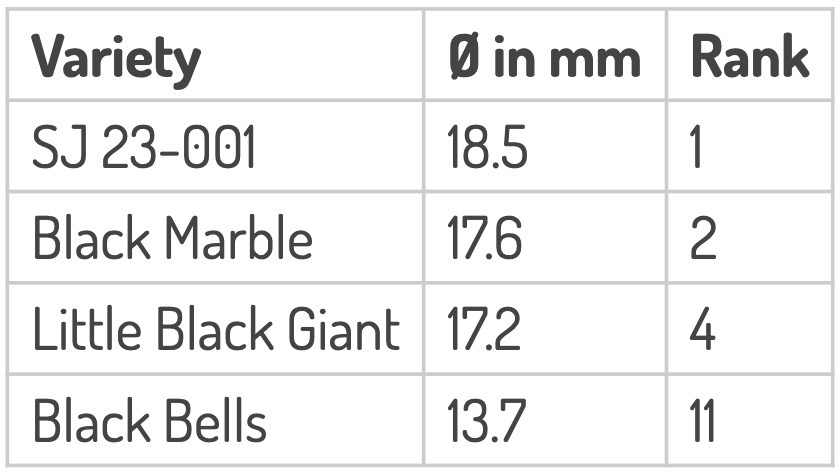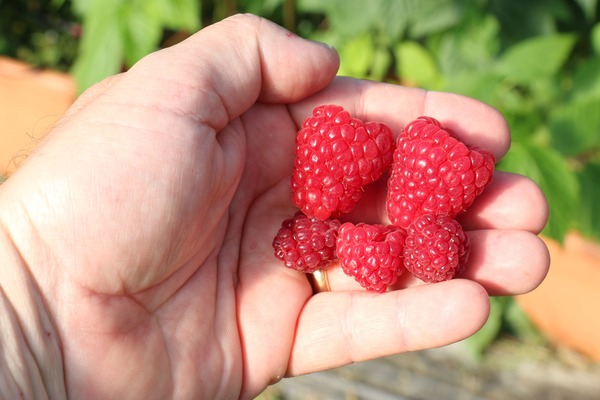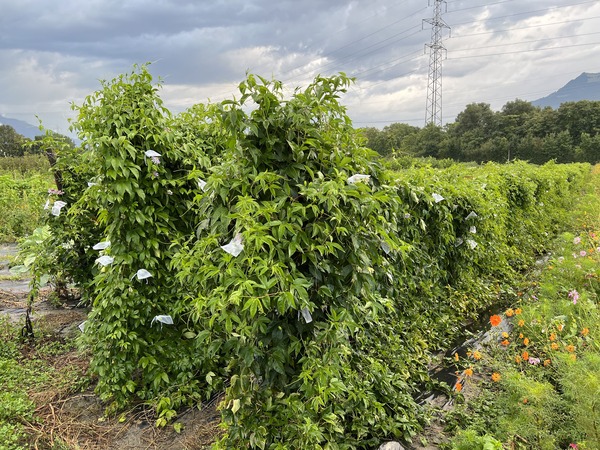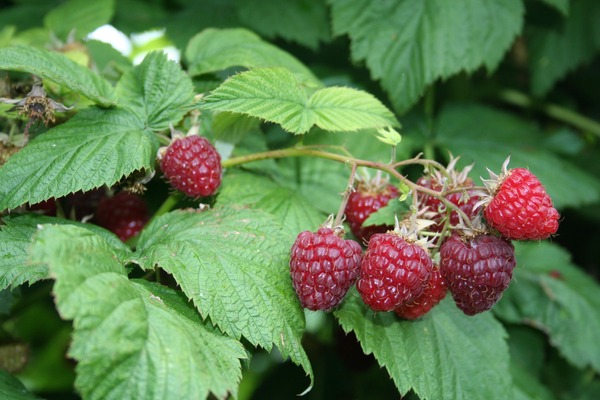 Why and for what does progress in breeding need to be made in plants for the home garden, especially in edible plants? Is there any advancement at all – or is it just less or more reproduction of the old, old wine being sold in new bottles? And if there are improvements, what are they focussed on and how can we sell them? These are the questions I would like to answer in this article, using raspberries as an example.
Why and for what does progress in breeding need to be made in plants for the home garden, especially in edible plants? Is there any advancement at all – or is it just less or more reproduction of the old, old wine being sold in new bottles? And if there are improvements, what are they focussed on and how can we sell them? These are the questions I would like to answer in this article, using raspberries as an example.
Breeding progress – yes or no?
Of course, my answer will hardly surprise you. Breeding progress is naturally less visible from year to year, from variety to variety, but as soon as we think back 20 to 40 years, it becomes so obvious that in many cases old classic varieties become almost 'embarrassing'. Yes, of course, almost 40 years ago ‘Autumn Bliss’ was a breakthrough in the breeding of autumn raspberries, finally the harvest was almost entirely in August, but today the small and sometimes crumbly fruits look rather pitiful. And yet the shelves are full of 40 to 60-year-old varieties.
Has this breeding progress also been made with other soft fruit varieties? Of course! Let's take the example of blackcurrants: just 30 years ago, the berries were around 5 mm in size, the bushes were susceptible to mildew and the flavour took some getting used to. With the new Cassissima® varieties, we have reached a fruit size of almost 2 cm, we have stable mildew resistance in all varieties and we have even succeeded in incorporating ornamental value in the first varieties (Black'n'Red® Premiere®).

Picture: Recording the average fruit sizes of the current assortment and the most promising selections

Picture: red-leafed black currant Black'n'Red® Premiere®
And what about the raspberries again? The fruit size of the summer raspberries has certainly increased by 50% and that of the autumn raspberries by 100% to 200%.

Picture: The relatively new autumn raspberry variety Primeberry® Autumn Chef® (above) in direct comparison to the well-known variety 'Autumn Bliss'. There is an age difference of well over 30 years between the two varieties. The obvious difference in size is significant. But it is not only in terms of fruit size that breeding is several decades ahead, but also in terms of flavour quality.
We are introducing more and more thornless raspberries into our range, and the ripening period for raspberries, which used to be limited to June and July, now lasts from June to October, provided the right variety is selected.
Would you like another example? Hardy passion fruit! The miracle of winter hardy passion fruit is of course explained by the use of the perennial species Passiflora incarnata, but the result is that an exotic fruit has suddenly been obtained for the garden in Central Europe. The simplicity, user-friendliness and diversity of the hardy Passiflora assortment are being continuously developed by Lubera's breeding department. So, is there progress in breeding? The answer is clearly YES.

Picture: Passiflora Breeding at Lubera in Buchs (CH)
Why is breeding progress underestimated?
In my opinion, breeding progress is systematically underestimated. Otherwise, the proportion of new varieties in the ranges would have to be significantly greater. Of course, I understand the price argument (old varieties are licence-free and production has long since learned how to propagate and produce them), but with this argument, we would still be buying Opel Admirals and VW Beetles. The decisive reason is probably that the plant producers are usually two to three marketing stages away from the end customer. They produce raspberry plants and not solutions for end consumers, for hobby gardeners. The marketing stages between producer and consumer, in turn, often understand too little about the product; for them, quantities, previous year's figures and labelling are more important than varietal characteristics. And this ultimately extends to the point of sale, which loses sight of the individual variety and solutions for real customers because of all the plants. Either there is a lack of information, or certainly a lack of time. And the result is that raspberry plants are sold again – the variety doesn't matter. Years ago, I saw a draft label for a new soft fruit label for our varieties on which the variety and its characteristics had simply been forgotten. Instead, there were certification stamps and branding components.
If thought through to the end, this development will sooner or later lead to fewer sales. Not only will raspberry plants become interchangeable, but because of the conformity of sizes and labelling, there will soon only be one product: berry plants. "What, you want to offer me berry plants for the summer, in 15 varieties and from four types of fruit, in oversized 5-litre pots, for the first harvest in the consumer's garden next year? We don't need that, we just had so many containers of mixed soft fruit in 2-litre pots on offer in the spring..."
The solution: solutions!
I've already mentioned it: we have to try to sell solutions for customer problems or at least for consumer inhibitions at all levels – and first of all, we need to make people aware of the problems. And to do this, we must – all together – leave the beaten track. For example, like so many nurserymen for almost 40 years now, I have explained to anyone who didn't want to hear it that there are summer and autumn raspberries, of course not without going on at length about how the early summer fruits grow on last year's old canes and the late autumn raspberries on this year's young shoots. "Excuse me? Can you explain that to me again? Does anyone care? Who has ever really understood it? Can we win over a younger generation to the edible garden in this way?And how do we explain the fact that the earliest autumn raspberries are already fruiting in July?
Of course, the ripening period itself is much more interesting for the hobby gardener than the mechanism behind it. They want a steady supply of fresh fruit for their daily muesli, and a concentrated harvest is important to them so that the fruit can be frozen and processed. Others, on the other hand, know that they are only at home for the harvest in September. This is precisely where the breeding of new varieties can score points since there are now varieties with ripening times from June to September.
| Month | What is ripe? | What varieties? |
| June | Raspberries on the two-year-old cane (we still have a gap in the range of early summer raspberries at Lubera Edibles) |
Twotimer®, Salmon berries, early floricane raspberries |
| July | late floricane rasperries, compact primocane raspberries | Little Sweet Sister®, Good as gold®, Little Orangelina® |
| August | This is where the ‘simplest’ raspberries ripen, which I still like to mistakenly call autumn raspberries. If you want to harvest a mass of raspberries simply and easily, this range is best for you. | Autumn First®, Autumn Happy®, Autumn Amber®, Autumn Chef® |
| September and October | Twotimer®-Raspberries with their yield at the tips of this year's canes sweeten a time of year when only a few berries are still to be expected |
Sugana®, Allyouneed® |
This continuity of ripening times, which now sounds so natural, the raspberry harvest from June to October, has only become possible thanks to new varieties, which are also constantly getting bigger, better and thornless. And as easy or simple as the argument about ripening times may sound, this is the only way to turn interchangeable raspberry plant varieties into solutions for objective customer problems (and buying resistances). When is the easiest time to harvest the best raspberries and am I really in the garden and at home?
New solutions for new customer problems – again using the example of raspberries
Thirty or forty years ago, the world was in order. Raspberries were grown in every garden for self-sufficiency, they tended not to be integrated into a deliberate 'design' and they were always around 180 to 250 cm high. This has changed – certainly also because gardens are getting smaller and smaller and our demands on the garden are becoming ever greater and, above all, more varied. The mixing of gardens, which is also due to the lack of space, and the combination of previously separate areas such as ornamental gardens, kitchen gardens, hedges and patios also leads to new demands. For example, the Lubera® customer service is receiving an increasing number of enquiries about how tall the raspberries will grow. Can they really fulfil the function of a hedge in the summer, or do they block the view of a part of the garden behind them? Thanks to our breeding programme at Lubera®, we can offer a new variety of growth heights, which at first glance seems almost obvious, but which dramatically improves the solutions available to the hobby gardener.
- 170-250 cm: classic, tall raspberries such as Autumn Happy® or Summer Chef®, Autumn Sun®, Autumn First®
- 120 to 150 cm: medium-height raspberries, especially the Schlaraffia® raspberry family
- Up to 100 cm: Lowberry® dwarf raspberries with a height of approx. 100 cm

Picture: graphical illustration of the different height groups
These differences in height and growth forms also open up new possibilities for using raspberries in the garden: growing them in containers or informal raspberry plantings scattered around the garden without infrastructure, without a framework or with just a short stake or pole.
The garden needs more solutions
Of course, there are many more such approaches that in retrospect feel self-evident: thornless raspberries such as Plentiful® and Autumn Happy® solve a customer issue (children in the garden), as do extremely large-fruited raspberries (Autumn Happy®, Autumn Chef®, Autumn Sun®, Twotimer® raspberries: easy harvesting, more juice, more enjoyment) or super robust varieties (Autumn Frist®, Sanibelle®), which also grow in problem locations.

Picture: Floricane raspberry ‘Sanibelle®’ also grows in rather unfavourable locations
The advantage of Lubera Edibles®: solutions, thanks to breeding and everything coming from a single source
Thanks to our in-house breeding at Lubera, we can offer exactly what you need: solutions, thanks to breeding. The breeding of edible plants at Lubera is consistently geared towards the hobby gardener, trying to deliver exactly what makes the garden easier and more enjoyable: more flavour, easier cultivation and more resistant plants. We can also offer another advantage that should not be underestimated: everything from a single source. Our customers do not have to buy young plants from three or five suppliers, as is the case in other plant areas, and then try to create an assortment with problem-solving offers. Lubera Edibles customers get everything from a single source: a large number of often new varieties with clear solution offers, reliable and scalable quantities and on top of that – for example in this newsletter – new approaches for solutions...
Because only those who sell solutions and not plants offer continuous and sustainable 'added value'. Every producer can deliver 'added value' in the form of pots and labels or even certificates, but ultimately everyone can do this (and the offers are correspondingly similar). Our extremely diverse range of varieties and, in particular, our Lubera® novelties provide additional sales arguments (for buyers and end customers alike) – because they solve real problems for hobby gardeners.
